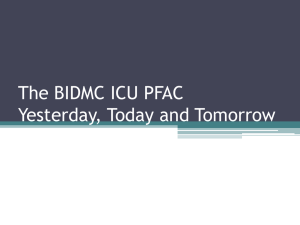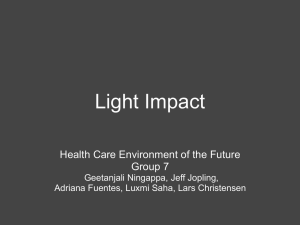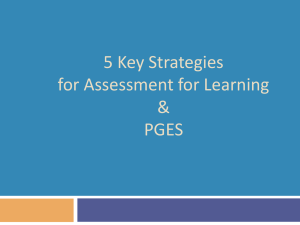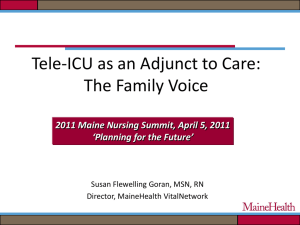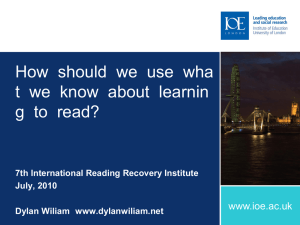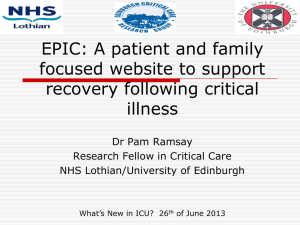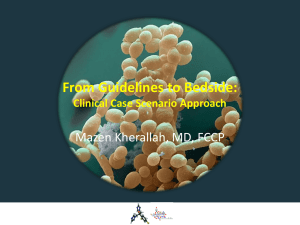Fungal infections in critically ill patients
advertisement
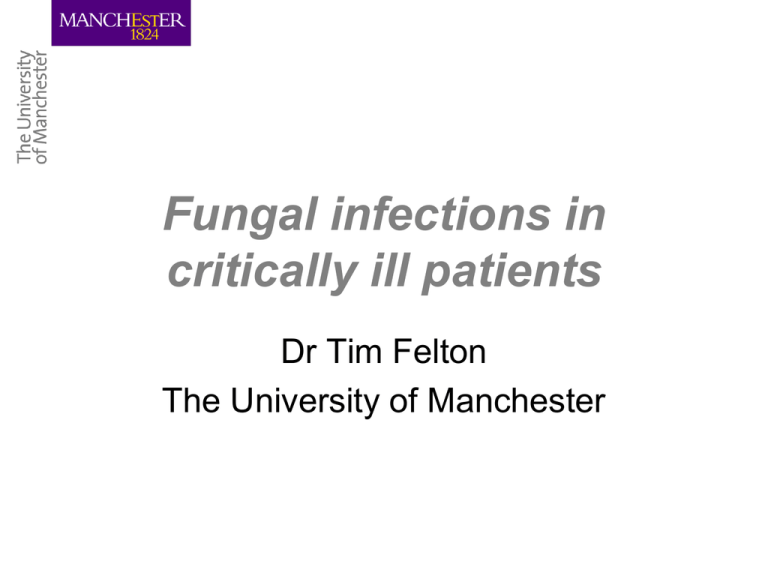
Fungal infections in critically ill patients Dr Tim Felton The University of Manchester Case study • • • • • 24 year old female Psoriasis with arthropathy Obesity (110kg) Admitted to ICU Methorexate 10mg weekly 1. H1N1 pneumonitis 2. ARDS 3. Pancytopenia 4. Severe sepsis Day 6 • Persistent sepsis • Respiratory failure (consider for ECMO) • Treated with broad-spectrum antibiotics • Identify Candida tropicalis from airways Is the Candida culture relevant? What would you do next? Would you treat? Day 7 • Identify Candida tropicalis from urine Is two Candida cultures relevant? What would you do next? Would you treat (and if so with what)? Treatment • Day 7 – Fluconazole 400mg daily • Day 14 – Caspofungin 70mg then 50mg • Day 20 – Ambisome 3mg/kg • Day 53 – RIP Epidemiology • 4th (9%) most common cause of blood stream infection in the US (and climbing…) • 6-10th most common in Europe • Incidence up to 10x higher in ICU patients • Attributable mortality 49-60% Candida species in ICU Bassetti 2006 Comert 2007 Laverdiere 2007 Italy Turkey Canada C. albicans 40% 66% 72% C. glabrata 15% 9% 16% C. parapsilosis 23% 11% C. tropicalis 9% Non-albicans Candida species • Increasingly reported as both colonisers and pathogens • Mortality – C. albicans ≈ 15 to 35% – C. tropicalis and C. glabrata ≈ 40 to 70% – C. parapsilosis ≈ 10 to15% Risk factors (compared to C. albicans) C. glabrata (Fluconazole prophylaxis), BMT, Surgery, Solid organ cancer C. tropicalis BMT, Solid tumours, Intravascular device C. krusei Neutropenia, Fluconazole prophylaxis, BMT C. parapsilosis Intravascular device, TPN, BMT, Neonates C. krusei Fluconazole prophylaxis C. lusitaniae Polyene use (inducible resistance) JoHI (2002) 50:243-260 Risk factors for Candidemia • • • • • • • • • Older age Diabetes mellitus Central venous lines Mechanical ventilation Multiple antibiotics Parenteral nutrition Major surgery Colonization Candiduria • • • • • • • • • Immunosuppression High APACHE II (>30) Prolonged neutropenia Uraemia Haemodialysis Low cardiac output Diarrhoea Extensive burns Acute pancreatitis JoHI (2007) 66: 201-206 Diagnostic tests • Blood culture – Sens 50%, spec 100% • (13)-β-D-glucan – Sens 70%, spec 87% • PCR – Sens 90%, spec 100% Mycoses 2010 53:424-433 Predictive scores • • • • Leon et al. 2006 1*(total parenteral nutrition) +1*(surgery) +1*(multifocal Candida species colonization) • +2*(severe sepsis) • Score >2.5 • Sensitivity 81% • Specificity 74% • Ostrosky-Zeichner et al. 2007 • Any systemic antibiotic (days 1–3) • OR CVC(days 1–3) • AND at least 2 of the following – – – – – – total parenteral nutrition (days 1–3) any dialysis (days 1–3) any major surgery (days −7–0) pancreatitis (days −7–0) any use of steroids (days −7–3) or use of other immunosuppressive agents (days −7–0) Colonisation scores • Pittet et al. 1994 • Colonization index • No. of non-blood body sites colonised (heavy growth) by Candida spp./total no. of sampled sites • 100% sensitivity and specificity. Treatment • • • • • • Early and appropriate Mortality (after +ve blood culture) Day 0 – 15% Day 1 – 24% Day 2 – 37% Later – 41% Garey et al. 2006 CID 43:25–31 Antifungal susceptibility Species Fluconazole Voriconazole Flucytosine Amphotericin B Echinocandins C. albicans S S S S S C. glabrata S – DD to R S – DD to R S S to I S C. tropicalis S S S S S C. parapsilosis S S S S S to R C. krusei R S I to R S to I S C. lusitaniae S S S S to R S CID (2009) 48:503–35 Prophylaxis • Reduces rates of colonisation to candidemia • May reduce mortality from candidemia • Probably helpful if – High levels of candidemia – Other infection controls measures are enforced – High risk individuals Pfaller et al. 2007. Clin Microbiol Rev 20:133–163 Pre-emptive treatment • Very few studies • Piarroux et al. 2004 • Bases of colonisation index • Reduced rates of invasive candidiasis (compared to historial controls) • Fluconazole Piarroux et al. 2004 CCM 32:2443–2449 Treatment Guery et al. 2009. ICM. 35;206-214 Treatment Case study • • • • • • 27 year old female Known asthmatic 3/7 increasing SOB, wheeze and cough Symbicort 200 2 puff bd + Bricanyl 500 prn No other PMHx (no DM) Ex-smoker In A+E • Bronchospasm and tachycopnea • Mild tachycardia and normotension • CXR Hyper-expanded but clear lung fields • Responded to nebs • Clarithromycin 500mg BD (penicillin allergy) • Prednisolone 40mg od 8 hours later…. • Decompensation • ICU - Intubation and MV • Resistant bronchospasm (sedation, muscle paralysis, ketamine and Sevoflurane) • Day 2 - persistent high grade fever (active cooling) Day 4 • Surveillance NBL – Aspergillus fumigatus • CXR – widespread airspace infiltrates (ALI) Is the Aspergillus culture relevant? What would you do next? Would you treat? Day 5 • Bronchoscopy and BAL – Culture positive for Aspergillus fumigatus. – No evidence of bacteria growth or acid-fast bacilli. • Serum Aspergillus PCR +ve. Is the Aspergillus culture/PCR relevant? What would you do next? Would you treat (and if so with what)? Treatment • Voriconazole (loaded then 4mg/Kg bd) then to PO • Continued for 6 months (Asp IgG 26) • TDM with • Caspofungin 70mg then 50mg for 30 days Follow up • • • • Retrospective Day 0 IgG + IgE to Asp –ve Day 8 Aspergillus IgG 148 mgA (0-40) Extubated on day 25 CT (day 31) widespread cavities, ground glass opacity and bronchiectasis • Environmental cultures –ve • No immune defect found AJRCCM. 2004;170: 621 • 127 of 1850 (6.9%) consecutive medical ICU admissions with IA or colonisation (micro/histol). • 89/127 (70%) did not have haematological malignancy • 67/89 proven/probable IA • 33 of 67 (50%) COPD • Mortality 80% (Predicted 48%) • 36/1756 patients (2%) • 20 IPA (defined as “pneumonia”) • 14 colonised • Mortality – Colonisation 50% – IPA 80% Risk factors in critical illness • Steroids (odds ratio = 4.5) – Prolonged corticosteroids treatment prior to ICU – Steroid treatment with a duration of 7 days • • • • • • • • • Immunosuppressive therapy Chronic obstructive pulmonary disease (odds ratio = 2.9) Liver cirrhosis Solid-organ cancer HIV Severe burns Prolonged stay in the ICU (>21 days) Malnutrition Post–cardiac surgery status Meersseman et al. CID. 2007;45: 205–16 Critical illness – risk factor? • Compensatory anti-inflammatory response syndrome – Monocyte/macrophage deactivation – Neutrophil deactivation – HLA-DR antigen expression – Loss of antigen-presenting capacity – synthesis of pro-inflammatory cytokines Environment • Pulmonary colonisation prior to ICU – Lobectomy, PM for unexpected cardiac death – 30/74 (41%) patients with Aspergillus species • Environmental contamination – High concentration of air-bourne spores Lass-Florl et al. BJH. 1999; 104:745-7 Respiratory tract samples • Colonisation or IPA? • 172 patients, Belgium ICUs, 7 years – 89 colonisation – 83 IPA (EORTC/MSG criteria) • Poor positive predicative value for IPA • But………………… AJRCCM . 2008;177: 27-34. • 110 ICU admission, IPA by EORTC/MSG criteria • 1/3 hematological malignancy interpret with care • BAL GM probably useful; Serum GM probably not Imaging • CT – Frequently absent – Halo sign, air crescent sign and nodules much more common in neutropenic patients – Difficult to interpret with ARDS Calliot et al. J Clin Oncol. 1997. 15:139-47 Other diagnostic tests • PCR – Not evaluated in critically ill patients • Biopsy – Gold standard – Difficult! Diagnosis in critical illness • High risk patients • Pulmonary infiltrates and fever, not responding to appropriate antibacterial agents • ± some concern that Aspergillus may be a diagnostic possibility – Recent unidentified case which died – Isolation of Aspergillus from respiratory tract Treatment in ICU • IDSA recommendations but little evidence in critically ill • Voriconazole – Hepatotoxicity and nephrotoxicity – IV formulation – cyclodextran – Substrate and inhibitor CYP2C19, 2C9 and 3A4 – bioavailabity with fat – requires empty stomach – TDM Treatment in ICU • Lipid preparations of Amphotericin B – Less nephrotoxic than deoxycholate • Eichinocandin – Salvage therapy • Combination Summary • Candida and Aspergillus increasingly recognised as ICU pathogens • Increased morbidity and mortality • High index of suspicion • Diagnostic strategy (clinical, radiology, lab) • Treatment is complicated – ADR, interactions
